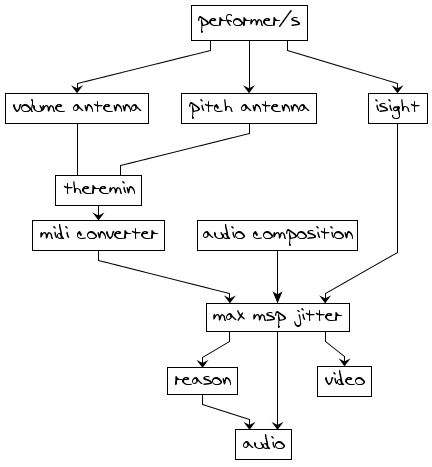last week i went to see temporal interference (ti), the next day i chatted with matt about the performance technologies in the show before i flew out to toronto. i’m not able to separate out our conversation so i’m just acknowledging matt’s input.
the primary interface for ti is a theremin suspended from the ceiling from which the pitch and volume antenna are dressed with plastic tubing that extends to the floor. an iSight (webcam) pointed between the two antenna towards the audience is the secondary secondary interface controlled by the theremin and max/msp . the installation also makes use of a sound system, video projector and scrim which you can see in the picture above and my map of the performance space.
you have probably heard a theremin even if you didn’t know what it was. the theremin’s two antenna have a electromagnetic field in which the resistance of your body actives the theremin. For ti the theremin used a ‘soft’ set-up to have a large electromagnetic field with minimal background interference. this type of set-up results in a significant loss of fine control and sensitivity in the interface. a ‘hard’ set-up is more complex and involves modifying the physical components of the theremin for greater range and control. hard set-up’s are complex and i believe that this was the desired set-up for ti, but was sadly not achieved.
From my brief experimentation (the system was live before the performance) it seemed as is the theremin had non-linear control. Given that the soft set-up used limits the control with which the theremin can be ‘played’, linear control would heave been more useful. Its much easier to ‘learn’ how to play a theremin with linear control. the accuracy with which you can play a linear control theremin is amazing. a few years ago i worked with four theremin installation and each thermin was expertly set-up. i really enjoyed developing the performance over time as the interface was regular, even if the audio processing shifted.
- Linear control: the physical distance between intervals /switches is evenly spaced along the entire interface (like a piano).
- Non-linear control: the physical distance between intervals / switches decreases along the interface (like a guitar).
i can usually tell if the interface i’m working with has linear control by watching the set-up. if the tech people are using a specific (measured) calibration method then it normally means there is linear control. this does not happen as much as i would like. interface control is important because it is how the performers (dancers or public) interact with the installation. this is a rough sketch of the interface & processing mapping in ti (thanks matt),
the midi values from the pitch and volume antenna are used by various max patches to affect audio (pitch, oscillation, synthesis etc.) and video ( zoom, fps, saturation, image permanence). in another post i might talk more about my physical experience of playing in the installation, but for now i suggest that you go play with ti and watch the performance yourself this weekend.
you might want to read ti 4 n00bs if you want a simpler version of this post.


Recent Comments